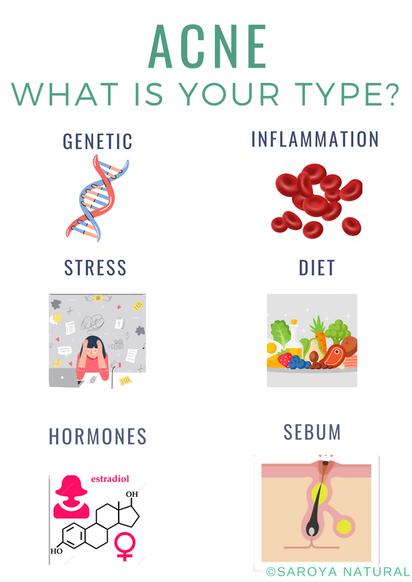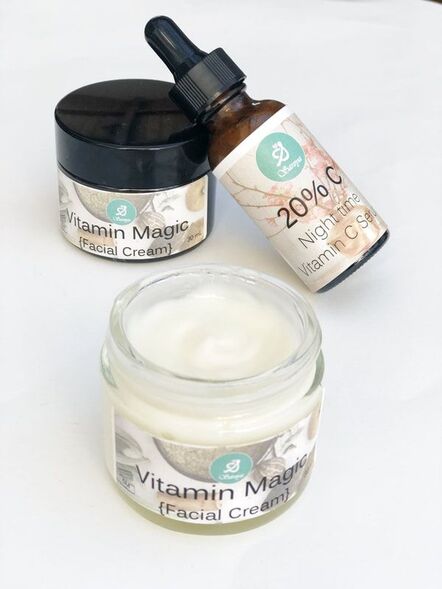|
Do you, or your loved one, suffer from acne? Do you feel like you've tried everything but nothing seems to work? There's good reason why most acne products don't work. The fundamental issues are:
What is acne? Acne is characterized as a chronic inflammatory disease. It presents as closed or open comedones - i.e. whiteheads and blackheads - and inflammatory lesions - i.e. pimples, nodules, pustules. Typically acne is prevalent in young adults with girls being affected at a younger age (average 12 years) than boys (average 15 years). Adults also suffer from acne, typically women, due to hormonal issues. Since acne is characterized as a disease, it is a medical condition. Causes of acne There are multiple factors that cause acne. Below are a few well known ones:
Current treatment for acne Modern treatment of acne falls under four categories:
By far, the most common treatment is topical - i.e. products applied on the affected area. The current practice for treating acne combines multiple methods and ingredients in the hope that one or more of them will address the patient's particular acne. The major drawback of such an approach is side effects of using too many products, bacterial resistance to antibiotics rendering them ineffective, and expense involved in buying multiple products. Ayurveda and acne Given how ancient Ayurveda is, it is quite remarkable how many of the modern acne pathways it covers. Below are various causes of acne that are addressed in Ayurveda:
In summary, both modern scientific research and Ayurveda point to multiple factors that cause acne. Therefore the most effective solution is one that is customized to your particular TYPE of acne. While there are many over the counter products for acne, you need to understand the cause of your particular type of acne and the ingredients that are suitable to address it for the products to be effective. The concentration of the active ingredients is also crucial in the efficacy of the products. The Ayurvedic approach offers the following benefits:
Sources:
https://www.ncbi.nlm.nih.gov/pmc/articles/PMC6560440/ https://www.ncbi.nlm.nih.gov/pmc/articles/PMC3051853/ https://www.ncbi.nlm.nih.gov/pmc/articles/PMC3780801/ https://www.ncbi.nlm.nih.gov/pmc/articles/PMC2835906/ https://www.aad.org/member/clinical-quality/guidelines/acne https://www.ncbi.nlm.nih.gov/pmc/articles/PMC6360964/ https://www.jidonline.org/action/showPdf?pii=S0022-202X%2815%2930101-9 https://www.ncbi.nlm.nih.gov/pmc/articles/PMC3366450/ https://www.mdpi.com/1420-3049/21/8/1063 https://www.researchgate.net/publication/330243222_Review_on_Yuvanpidika_Vis-A-Vis_Acne_Vulgaris
1 Comment
I am part of a Facebook group of female founders in beauty where someone asked the group to provide inputs on preservatives in cosmetics. Below is what I sent. Please note that there is a lot of misinformation around the use of preservatives. It is true that Saroya as a brand attempts to minimize products that have water and thereby remove the need of preservatives. But that choice is driven by many reasons beyond the need for preservatives.
Why are preservatives important in cosmetics? Preservatives are important in cosmetics for pretty much the same reasons they are important in other products, including food. They extend the shelf life of the product by inhibiting the growth of bacteria, mold, fungus, and yeast. Typically all cosmetic products that contain water need a preservative to have a shelf life that extends beyond a few days. What preservative(s) do you use in your products? Why? - My brand focuses on waterless formulations so I do not use preservatives in a lot of my products. For the few products that do contain water like creams and lotions, I use a preservative combination of gluconolactone and phenoxyehanol. Phenoxyethanol is a very easy to use preservative in that it does not impact the stability of cosmetic formulations. It is also effective. However, it is a skin irritant and I am personally allergic to phenoxyethanol. This particular combination works for me as I am able to reduce the concentration of phenoxyethanol to a point where it does not cause a reaction while being effective in doing the job of extending the shelf life. Update: I switched to a much more gentle preservation system made from fermenting radishes in combination with gluconolacctone. Leuconostoc radish root ferment filtrate is a probiotic preservative that also helps with skin moisturization and pH balance. My formulation philosophy still remains the same - i.e. avoid water and/or use self preserving ingredients which have skincare and antimicrobial properties . What is your opinion on parabens? I believe parabens have got a bad rap not necessarily backed by science. I personally have never used parabens but as a scientist I believe that a lot of things said about them are taken out of context or are not backed by facts. Some of the reasons that people believe parabens are bad are: a) They are endocrine disruptors. Yes, but so are many other things that contain phytoestrogens, including a lot of foods like soy. b) They cause cancer - this is really not backed by facts. The reason people believe parabens cause cancer is because there was a paper published that found parabens in breast cancer cells. Somehow this came to mean that parabens was the cause of the cancer. Do you use natural preservatives? Vegetable glycerin is not regarded as a preservative but it can enhance shelf life by binding to water. In that sense, yes, I do use naturally available ingredients as preservatives. Update: Leuconostoc radish root ferment filtrate is classified as a natural preservative. |
|
|
© Saroya Natural 2023 | All rights reserved.
Website designed by Aadi M |
Contact Us |



 RSS Feed
RSS Feed